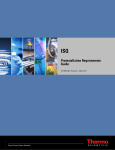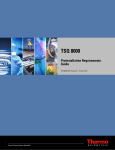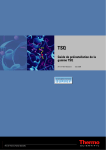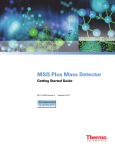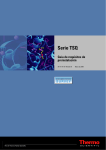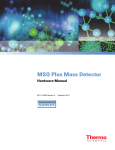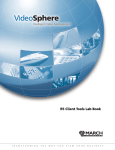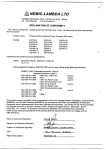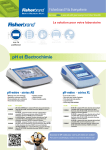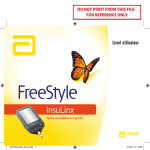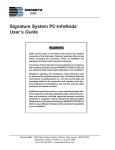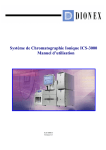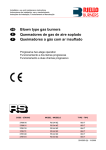Download MSQ Plus Mass Detector Preinstallation Guide
Transcript
MSQ Plus Mass Detector Preinstallation Guide 60111-97045 Revision A September 2013 © 2013 Thermo Fisher Scientific Inc. All rights reserved. Accela, Thermo Scientific, and Xcalibur are registered trademarks; and MSQ, MSQ Plus, and Optima are trademarks of Thermo Fisher Scientific in the United States. The following are registered trademarks in the United States and possibly other countries: Swagelok is a registered trademark of the Crawford Fitting Company. Dranetz is a registered trademark of Dranetz Technologies, Inc. Styrofoam is a registered trademark of Dow Chemical Company. Teflon is a registered trademark of E. I. du Pont de Nemours & Co. Peak Scientific is a registered trademark of Peak Scientific Instruments Limited. All other trademarks are the property of Thermo Fisher Scientific Inc. and its subsidiaries. Thermo Fisher Scientific Inc. provides this document to its customers with a product purchase to use in the product operation. This document is copyright protected and any reproduction of the whole or any part of this document is strictly prohibited, except with the written authorization of Thermo Fisher Scientific Inc. The contents of this document are subject to change without notice. All technical information in this document is for reference purposes only. System configurations and specifications in this document supersede all previous information received by the purchaser. Thermo Fisher Scientific Inc. makes no representations that this document is complete, accurate or errorfree and assumes no responsibility and will not be liable for any errors, omissions, damage or loss that might result from any use of this document, even if the information in the document is followed properly. This document is not part of any sales contract between Thermo Fisher Scientific Inc. and a purchaser. This document shall in no way govern or modify any Terms and Conditions of Sale, which Terms and Conditions of Sale shall govern all conflicting information between the two documents. Release history: Revision A September 2013 Software version: (Thermo) MSQ Plus Mass Detector 2.0 or later; Xcalibur 2.2 SP1 or later; Foundation 2.0 SP1, 2.1, 3.0 or later For Research Use Only. Not for use in diagnostic procedures. IMPORTANT PREINSTALLATION INFORMATION... PLEASE READ MSQ Plus Mass Detector Installation Request Form Dear User: Read the MSQ Plus Mass Detector Preinstallation Requirements Guide, and then print and complete the following installation request form. After all items on the form are fulfilled, sign and date the form. Then, mail or fax this form to your local Thermo Fisher Scientific sales/service office. The address and fax number for your local office are located on the following pages. 1. All laboratory remodeling has been completed. 2. Your MSQ Plus Mass Detector is on site. 3. Principal operator will be available during the installation / certification period. 4. Doorways, hallways, and so on are a minimum width of 94 cm (37 in.). 5. Available floor area is sufficient and flooring will support the load. 6. Sufficient bench space is available for all of the equipment. List the following: Width: ____________________________ Depth: ____________________________ Height: ____________________________ 7. Workbench can support the load of the system [215 kg (470 lbs)] and is free from vibration. 8. Lighting is adequate. 9. Main power is installed and is in compliance with local electrical codes. 10. Power for test and cleaning equipment is installed. 11. Power outlets are of the correct configuration. Note NEMA type: ____________________ 12. Voltage of power outlet has been measured. Note measured voltage: ______________ 13. Power is free from fluctuations due to slow changes in the average voltage or changes due to surges, sags, or transients. 14. Air conditioning is adequate for temperature, humidity, and particulate matter control. The laboratory can be maintained at a constant temperature, between 15 and 27 C (59 and 81 F). 15. Relative humidity is between 40% and 80% with no condensation. 16. System work area is free from magnetic disruption and electrostatic discharge. 17. All gases required (argon and nitrogen) are on site, gas lines are installed, and appropriate gas regulators are available. List gases and purity: __________________ 18. New or recently cleaned HPLC system is available that produces pulse-free, continuous flow from 100 to 1000 L/min. 19. HPLC grade water, methanol, acetonitrile and isopropyl alcohol are available for testing the performance of your instrument. 20. There is a suitable exhaust system present that is separate from solvent waste. 21. Provision has been made for collecting solvent waste from API source. 22. One voice telephone line is installed near the system. 23. All relevant safety regulations are complied with. Have any special acceptance specifications been agreed to in the contract? If YES, attach full details of specifications. Yes No Is there any additional equipment that needs to be interfaced to the system? If YES, attach full details of additional equipment. Yes No Note: We reserve the right to invoice against the engineer’s time if the installation requirements are not met on the date of the installation. Print your name, company name, and company address clearly below: Name ________________________________________________________ Company _____________________________________________________ Telephone____________________ Address ___________________________________________________________________________________ Address ___________________________________________________________________________________ City ______________________________________ State _____________ Country______________________ Signature _____________________________________________________ Date ________________________ Chromatography and Mass Spectrometry Offices For up-to-date contact information, visit www.thermoscientific.com/wps/portal/ts/contactus. North America France United States (Also representing French-speaking North Africa, Algeria, Morocco, and Tunisia) 1400 North Point Pkwy #10 West Palm Beach, FL 33407 E-mail: [email protected] Phone.........................[1] 800 532 4752 Fax .............................[1] 877 373 4006 Canada 2845 Argentia Road, Unit 4 Mississauga, Ontario, L5N 8G6 E-mail: [email protected] Phone.........................[1] 800 530 8447 Fax .............................[1] (905) 890 9161 Europe Austria Wehlistrasse 27b A-1200 Wien E-mail: [email protected] Phone.........................[43] (0) 1 333 50 34-0 Fax .............................[43] (0) 1 333 50 34-26 Belgium Clintonpark “Keppekouter” Ninovesteenweg 198 B-9320 ERMEBODEGEM - AALST E-mail: [email protected] Phone.........................[32] (0) 2 482 3030 Fax .............................[32] (0) 2 482 3031 Denmark Fruebjergvej 3 2100 København Ø E-mail: [email protected] Phone.........................[45] (70) 236267 Fax .............................[45] (70) 236263 16 Avenue du Québec Silic 765 Z.A. de Courtaboeuf F-91963 Les Ulis Cédex E-mail: [email protected] Phone .........................[33] (0) 1 60 92 49 50 Fax .............................[33] (0) 1 60 92 48 99 Germany Im Steingrund 4-6 D-63303 Dreieich E-mail: [email protected] Phone .........................[49] (0) 6103 408 1050 Fax .............................[49] (0) 6103 408 1213 Italy Strada Rivoltana I-20090 Rodano (Milano) E-mail: [email protected] Phone .........................Numero Verde (800) 823 162 Fax .............................[39] (02) 95320 225 Netherlands Takkebijsters 1 NL-4817 BL Breda E-mail: [email protected] Phone .........................[31] (0) 76 579 55 55 Fax .............................[31] (0) 76 581 09 61 Norway—see “Sweden, Norway, and Finland” Spain C/Valportillo I, no22 1a Planta Edificio Caoba ES-28108 Alcobendas - Madrid E-mail: [email protected] Phone .........................[34] (914) 845 965 Fax .............................[34] (914) 843 598 Finland—see “Sweden, Norway, and Finland” Notes: The country code is enclosed in square brackets [ ]. The city code or area code is enclosed in parenthesis ( ). For countries other than the U.S., when you are dialing from within the specified country, dial the 0 of the city code. For countries other than Italy, when you are dialing from outside the country, do not dial the 0 of the city code. Chromatography and Mass Spectrometry Offices (Continued) Europe—continued Sweden, Norway, and Finland Pyramidbacken 3 S-141 75 Kungens Kurva (Stockholm) Sweden E-mail: [email protected] Phone.........................[46] (0) 8 556 468 20 Fax .............................[46] (0) 8 556 468 08 Switzerland Neuhofstrasse 11 4153 Reinach E-mail: [email protected] Phone.........................[41] (617) 16 77 40 Fax .............................[41] (617) 16 77 20 United Kingdom Stafford House 1 Boundary Park Boundary Way Hemel Hempstead Hertfordshire HP2 7GE E-mail: [email protected] Phone ........................[44] (0) 870 241 1034 Fax .............................[44] (0) 1442 233 667 Australasia and Asia Australia P.O. Box 9092 5 Caribbean Drive Scoresby, VIC 3179 E-mail: [email protected] Phone.........................[61] 39757 4300 Fax .............................[61] 9763 1169 Japan C-2F 3-9 Moriya-cho, Kanagawa-ku Yokohama 221-0022 E-mail: [email protected] Phone.........................[81] (45) 453 9100 Fax .............................[81] (45) 453 9110 P.R. China 7/F Building F, Tower West, Younghe Plaza No. 28, Andingmen East Street Dong Cheng District Beijing 100007 E-mail: [email protected] Phone ........................[86] (010) 8419 3588 Fax .............................[86] (010) 8419 3589 Regulatory Compliance Thermo Fisher Scientific performs complete testing and evaluation of its products to ensure full compliance with applicable domestic and international regulations. When the system is delivered to you, it meets all pertinent electromagnetic compatibility (EMC) and safety standards as described in the next section or sections by product name. Changes that you make to your system may void compliance with one or more of these EMC and safety standards. Changes to your system include replacing a part or adding components, options, or peripherals not specifically authorized and qualified by Thermo Fisher Scientific. To ensure continued compliance with EMC and safety standards, replacement parts and additional components, options, and peripherals must be ordered from Thermo Fisher Scientific or one of its authorized representatives. EMC Directive 89/336/EEC as amended by 92/31/EEC and 93/68/EEC EMC compliance has been evaluated by UNDERWRITERS LABORATORY, INC (UL). EN 55011 (1998) EN 61000-4-3 (2002) EN 61326-1 (1998) EN 61000-4-4 (2001) EN 61000-3-2 1995 EN 61000-4-5 (2001) EN 61000-3-3 1995 EN 61000-4-6 (2001) EN 61000-4-2 (2001) EN 61000-4-11 (2001) CFR 47 Part 15 Subpart B: 2004 Code of Federal Regulations, Part 15, Subpart B, Radio Frequency Devices Unintentional Radiators Class A Low-Voltage Safety Compliance This device complies with the EU directive 73/23/EEC (equivalent to IEC 1010-1, 1990 plus Amendment 1, 1991 and Amendment 2, 1995) by meeting the following standard: EN 61010-1: 2001 with Corrigendum No. 1 and 2. FCC Compliance Statement THIS DEVICE COMPLIES WITH PART 15 OF THE FCC RULES. OPERATION IS SUBJECT TO THE FOLLOWING TWO CONDITIONS: (1) THIS DEVICE MAY NOT CAUSE HARMFUL INTERFERENCE, AND (2) THIS DEVICE MUST ACCEPT ANY INTERFERENCE RECEIVED, INCLUDING INTERFERENCE THAT MAY CAUSE UNDESIRED OPERATION. CAUTION Read and understand the various precautionary notes, signs, and symbols contained inside this manual pertaining to the safe use and operation of this product before using the device. Notice on Lifting and Handling of Thermo Scientific Instruments For your safety, and in compliance with international regulations, the physical handling of this Thermo Fisher Scientific instrument requires a team effort to lift and/or move the instrument. This instrument is too heavy and/or bulky for one person alone to handle safely. Notice on the Proper Use of Thermo Scientific Instruments In compliance with international regulations: This instrument must be used in the manner specified by Thermo Fisher Scientific to ensure protections provided by the instrument are not impaired. Deviations from specified instructions on the proper use of the instrument include changes to the system and part replacement. Accordingly, order replacement parts from Thermo Fisher Scientific or one of its authorized representatives. Notice on the Susceptibility to Electromagnetic Transmissions Your instrument is designed to work in a controlled electromagnetic environment. Do not use radio frequency transmitters, such as mobile phones, in close proximity to the instrument. For manufacturing location, see the label on the instrument. WEEE Compliance This product is required to comply with the European Union’s Waste Electrical & Electronic Equipment (WEEE) Directive 2002/96/EC. It is marked with the following symbol: Thermo Fisher Scientific has contracted with one or more recycling or disposal companies in each European Union (EU) Member State, and these companies should dispose of or recycle this product. See www.thermoscientific.com/ rohsweee for further information on Thermo Fisher Scientific’s compliance with these Directives and the recyclers in your country. WEEE Konformität Dieses Produkt muss die EU Waste Electrical & Electronic Equipment (WEEE) Richtlinie 2002/96/EC erfüllen. Das Produkt ist durch folgendes Symbol gekennzeichnet: Thermo Fisher Scientific hat Vereinbarungen mit Verwertungs-/Entsorgungsfirmen in allen EU-Mitgliedsstaaten getroffen, damit dieses Produkt durch diese Firmen wiederverwertet oder entsorgt werden kann. Mehr Information über die Einhaltung dieser Anweisungen durch Thermo Fisher Scientific, über die Verwerter, und weitere Hinweise, die nützlich sind, um die Produkte zu identifizieren, die unter diese RoHS Anweisung fallen, finden sie unter www.thermoscientific.com/rohsweee. Conformité DEEE Ce produit doit être conforme à la directive européenne (2002/96/EC) des Déchets d'Equipements Electriques et Electroniques (DEEE). Il est marqué par le symbole suivant: Thermo Fisher Scientific s'est associé avec une ou plusieurs compagnies de recyclage dans chaque état membre de l’union européenne et ce produit devrait être collecté ou recyclé par celles-ci. Davantage d'informations sur la conformité de Thermo Fisher Scientific à ces directives, les recycleurs dans votre pays et les informations sur les produits Thermo Fisher Scientific qui peuvent aider la détection des substances sujettes à la directive RoHS sont disponibles sur www.thermoscientific.com/rohsweee. C Contents Preface . . . . . . . . . . . . . . . . . . . . . . . . . . . . . . . . . . . . . . . . . . . . . . . . . . . . . . . . . . . . .xiii Related Documentation . . . . . . . . . . . . . . . . . . . . . . . . . . . . . . . . . . . . . . . . . .xiii Safety and Special Notices . . . . . . . . . . . . . . . . . . . . . . . . . . . . . . . . . . . . . . . .xiv Safety Precautions. . . . . . . . . . . . . . . . . . . . . . . . . . . . . . . . . . . . . . . . . . . . . . . xv Contacting Us . . . . . . . . . . . . . . . . . . . . . . . . . . . . . . . . . . . . . . . . . . . . . . . . .xvi Thermo Scientific Chapter 1 Introduction . . . . . . . . . . . . . . . . . . . . . . . . . . . . . . . . . . . . . . . . . . . . . . . . . . . . . . . . . . .1 Chapter 2 Site Preparation. . . . . . . . . . . . . . . . . . . . . . . . . . . . . . . . . . . . . . . . . . . . . . . . . . . . . . . .3 Entrance . . . . . . . . . . . . . . . . . . . . . . . . . . . . . . . . . . . . . . . . . . . . . . . . . . . . . . . 4 Space and Load Requirements . . . . . . . . . . . . . . . . . . . . . . . . . . . . . . . . . . . . . . . 4 Telephone . . . . . . . . . . . . . . . . . . . . . . . . . . . . . . . . . . . . . . . . . . . . . . . . . . . . . . 7 Chapter 3 Operating Environment. . . . . . . . . . . . . . . . . . . . . . . . . . . . . . . . . . . . . . . . . . . . . . . . . .9 Temperature . . . . . . . . . . . . . . . . . . . . . . . . . . . . . . . . . . . . . . . . . . . . . . . . . . . 10 Humidity . . . . . . . . . . . . . . . . . . . . . . . . . . . . . . . . . . . . . . . . . . . . . . . . . . . . . 11 Vibration. . . . . . . . . . . . . . . . . . . . . . . . . . . . . . . . . . . . . . . . . . . . . . . . . . . . . . 11 Lighting. . . . . . . . . . . . . . . . . . . . . . . . . . . . . . . . . . . . . . . . . . . . . . . . . . . . . . . 11 Particulate Matter . . . . . . . . . . . . . . . . . . . . . . . . . . . . . . . . . . . . . . . . . . . . . . . 12 Electrostatic Discharge . . . . . . . . . . . . . . . . . . . . . . . . . . . . . . . . . . . . . . . . . . . 12 Chapter 4 Line Power . . . . . . . . . . . . . . . . . . . . . . . . . . . . . . . . . . . . . . . . . . . . . . . . . . . . . . . . . . .15 Quality of Power . . . . . . . . . . . . . . . . . . . . . . . . . . . . . . . . . . . . . . . . . . . . . . . . 18 Power-Monitoring Devices . . . . . . . . . . . . . . . . . . . . . . . . . . . . . . . . . . . . . . . . 18 Power-Conditioning Devices. . . . . . . . . . . . . . . . . . . . . . . . . . . . . . . . . . . . . . . 19 Available Outlets . . . . . . . . . . . . . . . . . . . . . . . . . . . . . . . . . . . . . . . . . . . . . . . . 19 Connecting the MS, LC, and Other Modules to Wall Outlets . . . . . . . . . . . . . 23 Uninterruptible Power Supply. . . . . . . . . . . . . . . . . . . . . . . . . . . . . . . . . . . . . . 24 Technical Assistance . . . . . . . . . . . . . . . . . . . . . . . . . . . . . . . . . . . . . . . . . . . . . 25 Chapter 5 Gases and Solvents. . . . . . . . . . . . . . . . . . . . . . . . . . . . . . . . . . . . . . . . . . . . . . . . . . . .27 Fittings and Parts. . . . . . . . . . . . . . . . . . . . . . . . . . . . . . . . . . . . . . . . . . . . . . . . 28 Gases . . . . . . . . . . . . . . . . . . . . . . . . . . . . . . . . . . . . . . . . . . . . . . . . . . . . . . . . . 28 Solvent Recommendations . . . . . . . . . . . . . . . . . . . . . . . . . . . . . . . . . . . . . . . . 29 MSQ Plus Mass Detector Preinstallation Guide xi Contents Chapter 6 Waste and Exhaust . . . . . . . . . . . . . . . . . . . . . . . . . . . . . . . . . . . . . . . . . . . . . . . . . . . .31 Exhaust System . . . . . . . . . . . . . . . . . . . . . . . . . . . . . . . . . . . . . . . . . . . . . . . . . 32 Forepump Exhaust . . . . . . . . . . . . . . . . . . . . . . . . . . . . . . . . . . . . . . . . . . . . 32 Electrospray/APCI Exhaust . . . . . . . . . . . . . . . . . . . . . . . . . . . . . . . . . . . . . . 34 Solvent Waste . . . . . . . . . . . . . . . . . . . . . . . . . . . . . . . . . . . . . . . . . . . . . . . . . . 35 Chapter 7 Instrument Arrival . . . . . . . . . . . . . . . . . . . . . . . . . . . . . . . . . . . . . . . . . . . . . . . . . . . . .37 Receiving Material. . . . . . . . . . . . . . . . . . . . . . . . . . . . . . . . . . . . . . . . . . . . . . . 37 Domestic Shipments . . . . . . . . . . . . . . . . . . . . . . . . . . . . . . . . . . . . . . . . . . . . . 37 International Shipments . . . . . . . . . . . . . . . . . . . . . . . . . . . . . . . . . . . . . . . . . . 38 Chapter 8 Installation . . . . . . . . . . . . . . . . . . . . . . . . . . . . . . . . . . . . . . . . . . . . . . . . . . . . . . . . . . .39 Preinstallation Survey . . . . . . . . . . . . . . . . . . . . . . . . . . . . . . . . . . . . . . . . . . . . 40 Installation Kits and Components . . . . . . . . . . . . . . . . . . . . . . . . . . . . . . . . . . . 41 Installation . . . . . . . . . . . . . . . . . . . . . . . . . . . . . . . . . . . . . . . . . . . . . . . . . . . . 42 Preventive Maintenance . . . . . . . . . . . . . . . . . . . . . . . . . . . . . . . . . . . . . . . . . . 42 Index . . . . . . . . . . . . . . . . . . . . . . . . . . . . . . . . . . . . . . . . . . . . . . . . . . . . . . . . . . . . . . . .43 xii MSQ Plus Mass Detector Preinstallation Guide Thermo Scientific P Preface This guide describes how to plan for and prepare your laboratory site before delivery and installation of the Thermo Scientific™ MSQ Plus™ Mass Detector. Read each section carefully to ensure that your laboratory is ready for the installation of the system. Contents • Related Documentation • Safety and Special Notices • Safety Precautions • Contacting Us To suggest changes to documentation or to Help Complete a brief survey about this document by clicking the button below. Thank you in advance for your help. Related Documentation In addition to this guide, Thermo Fisher Scientific provides the following documents for the MSQ Plus Mass Detector: • MSQ Plus Mass Detector Hardware Manual • MSQ Plus Mass Detector Getting Started Guide • MSQ Plus Mass Detector Getting Connected • MSQ Plus Mass Detector Calmix Kit Preparation Guide • Dionex AXP/AXP-MS Metering Pump Operator’s Manual • Dionex Chromelon/MSQ Plus Operator’s Guide Thermo Scientific MSQ Plus Mass Detector Preinstallation Guide xiii Preface Safety and Special Notices • Dionex MSQ Plus Facilities Preinstallation Requirements Guide • Dionex MSQ Hardware Manual • Dionex Installation and Commissioning Guide • Dionex MSQ Preventive Maintenance • Dionex MSQ10LA Nitrogen Generator for Mass Spectrometers • Dionex MSQ18LA Nitrogen Generator for Mass Spectrometers • Dionex N118LOA/N418LA Unpacking & Installation • Dionex N*18KLA Nitrogen Generator User Manual • Dionex MSQ Getting Started • Safety and Regulatory Guide You also receive a printed copy of the Safety and Regulatory Guide with your MSQ Plus Mass Detector. This guide contains important safety information about Thermo Scientific LC and MS systems. Make sure that all lab personnel have read and have access to this document. The software also provides Help. Safety and Special Notices Make sure you follow the precautionary statements presented in this guide. The safety and other special notices appear in boxes. Safety and special notices include the following: CAUTION Highlights hazards to humans, property, or the environment. Each CAUTION notice is accompanied by an appropriate CAUTION symbol. IMPORTANT Highlights information necessary to prevent damage to software, loss of data, or invalid test results; or might contain information that is critical for optimal performance of the system. Note Highlights information of general interest. Tip Highlights helpful information that can make a task easier. xiv MSQ Plus Mass Detector Preinstallation Guide Thermo Scientific Preface Safety Precautions Safety Precautions Observe the following safety precautions when you operate or perform service on the MSQ Plus Mass Detector: CAUTION Do not perform any servicing other than that contained in the MSQ Plus Mass Detector Hardware Manual. To avoid personal injury or damage to the instrument, do not perform any servicing other than that contained in the MSQ Plus Mass Detector Hardware Manual or related manuals unless you are qualified to do so. CAUTION Shut down the mass detector and disconnect it from line power before you service it. High voltages capable of causing personal injury are used in the instrument. Some maintenance procedures require that the mass detector be shut down and disconnected from line power before service is performed. Do not operate the mass detector with the top or side covers off. Do not remove protective covers from PCBs. CAUTION Do not interfere with the safety interlock. Interfering with the safety interlock will expose you to potentially lethal electrical hazards. CAUTION Respect heated zones. Treat heated zones with respect. The ion transfer capillary and the APCI vaporizer might be very hot and might cause severe burns if touched. Allow heated components to cool before you service them. CAUTION Place the mass detector in Standby (or Off ) mode before you open the atmospheric pressure ionization (API) source. The presence of atmospheric oxygen in the API source when the mass detector is on could be unsafe. The mass detector automatically goes into standby mode when you open the API source; however, take this added precaution for safety reasons. CAUTION Take care when handling the corona pin. The corona pin is sharp and can cause personal injury. Take care when removing or installing the corona pin. CAUTION Make sure you have sufficient nitrogen for your API source. Before you begin normal operation each day, make sure that you have sufficient nitrogen for your API source. The presence of atmospheric oxygen in the API source when the mass detector is on could be unsafe. Thermo Scientific MSQ Plus Mass Detector Preinstallation Guide xv Preface Contacting Us CAUTION Contain waste streams. Because the API source can accommodate high solvent flow rates, you must make provisions to collect the waste solvent. CAUTION Provide adequate fume exhaust systems for the API source solvent waste container and the forepump. Your laboratory must be equipped with at least two fume exhaust systems: one to vent the waste container connected to the exhaust port (API solvent drain) on the back of the mass detector and the other to vent the forepump exhaust. As described in the MSQ Plus Mass Detector Getting Connected Guide, route the (blue) forepump exhaust hose to a dedicated fume exhaust system. Because the exhaust hose acts as a trap for exhaust fumes that would otherwise recondense in the forepump oil, the hose should travel at floor level for a minimum of two meters (78.5 in.) before it reaches the external exhaust system. Route tubing from the waste container connected to the exhaust port on the back of the mass detector to a second dedicated fume exhaust system. Consult local regulations for the proper method of exhausting the fumes from your system. Do not vent the PVC drain tube (or any vent tubing connected to the waste container) to the same fume exhaust system that is connected to the forepump. The forepump exhaust contains pump oil, which can seriously contaminate the analyzer optics of the mass spectrometer. Contacting Us There are several ways to contact Thermo Fisher Scientific for the information you need. To contact Technical Support Phone 800-532-4752 Fax 561-688-8736 E-mail [email protected] Knowledge base www.thermokb.com Find software updates and utilities to download at mssupport.thermo.com. To contact Customer Service for ordering information xvi Phone 800-532-4752 Fax 561-688-8731 E-mail [email protected] Web site www.thermo.com/ms MSQ Plus Mass Detector Preinstallation Guide Thermo Scientific Preface Contacting Us To get local contact information for sales or service Go to www.thermoscientific.com/wps/portal/ts/contactus. To copy manuals from the Internet Go to mssupport.thermo.com, agree to the Terms and Conditions, and then click Customer Manuals in the left margin of the window. To suggest changes to documentation or to Help • Fill out a reader survey online at www.surveymonkey.com/s/PQM6P62. • Send an e-mail message to the Technical Publications Editor at [email protected]. Thermo Scientific MSQ Plus Mass Detector Preinstallation Guide xvii 1 Introduction The MSQ Plus Mass Detector is designed to operate under carefully controlled environmental conditions. You are responsible for providing a suitable location and operating environment, a source of power of acceptable quality, correct gas and solvent supplies, and proper waste and exhaust systems. CAUTION Operating a system or maintaining it outside the power and operating environment specifications described in this guide might cause failures of many types. The repair of such failures is specifically excluded from the standard warranty and service contract coverage. For additional information, request specific preinstallation support directly through your local Thermo Fisher Scientific office (see “Chromatography and Mass Spectrometry Offices” on page v). Thermo Scientific MSQ Plus Mass Detector Preinstallation Guide 1 2 Site Preparation This chapter describes the physical requirements that your site must meet to accommodate the MSQ Plus Mass Detector. Contents • Entrance • Space and Load Requirements • Telephone Before a Thermo Fisher Scientific service engineer can install your instrument, you must prepare the site. Transportation of the equipment to the site requires wide entrances and hallways. Supporting the weight of the mass detector, computer, and liquid chromatography (LC) system requires large and strong workbenches. You must install a telephone within reach of the workbench. See Table 1 for a summary of site preparation requirements, and see the pages indicated in the table for details. Table 1. Site preparation requirements Requirement Page Entrance: 4 For the system to be delivered to the site, your entrances and hallways must be a minimum of 70 cm (28 in.) wide for passage of the instrument. 4 Space and Load Requirements: The total workbench surface must have minimum dimensions of 0.9 × 2 m (3 × 6 ft) to support the MSQ Plus Mass Detector, the Accela LC system, the optional cone wash pump, and the data system with user-supplied printer. The workbench surface must be capable of supporting the weight of the MSQ Plus Mass Detector [60 kg (132 lbs)] and the data system (with printer) [39 kg (86 lbs)] plus the weight of your liquid chromatograph and any options. Telephone: 7 A telephone line must be installed near the workbench. Thermo Scientific MSQ Plus Mass Detector Preinstallation Guide 3 2 Site Preparation Entrance You are responsible for providing an acceptable installation site. IMPORTANT The MSQ Plus Mass Detector must be located within 2.5 m of a connection to an external laboratory vent. Entrance The entrance to your facility and the width of all hallways, elevators, and so on must be a minimum of 70 cm (28 in.).1 However, you must also allow additional room for maneuvering the system around corners, into elevators, or through doorways. The MSQ Plus Mass Detector and accessories are shipped in a container with a length of 112 cm (44 in.), a width of 70 cm (28 in.), and a height of 78 cm (31 in.). The container and its contents weigh approximately 60 kg (132 lb).2 Other modules, such as the computer, forepump, monitor, and options, are shipped in their own containers. Their dimensions and weights are less than that of the container for the MSQ Plus Mass Detector. Space and Load Requirements See Figure 1 for the MSQ Plus Mass Detector system installation and space requirements. See Table 2 for the space requirements and weights of typical MSQ Plus Mass Detector LC/MS system components. 1 Your instrument is shipped in a shipping container with a smallest dimension of 70 cm (28 in.). If the entrance to your laboratory will not accommodate a 92 cm (36.22 in.) container, you can remove the individual modules from the container before moving them into the room. If you remove the instrument from its shipping container before it is delivered to the lab site, be sure that all the contents of the container remain with the instrument. 2 If the instrument shipping container, Shock Watch, or other indicators show any evidence of damage or mishandling during shipment, do NOT open the container. Call your Thermo Fisher Scientific representative for instructions on what to do. If there is no evidence of shipping damage or mishandling, then you can proceed with the instructions that follow. 4 MSQ Plus Mass Detector Preinstallation Guide Thermo Scientific 2 Site Preparation Space and Load Requirements Figure 1. Space requirements for your MSQ Plus Mass Detector system Accela LC system 36 cm (14 in.) ACCELA MSQ Plus Mass Detector 30 cm (12 in.) Monitor 41 cm (16 in.) PDA Detector Power Communication Run Lamps 114 cm (45 in.) ACCELA Autosampler Power Communication Run Data system computer 19 cm (7 in.) User-supplied printer 41 cm (16 in.) Temperature Cone wash pump To vent for forepump exhaust ACCELA Pump Power 76 cm (30 in.) Communication Run Degas To vent N418LA Oil Mist Filter EMF 20 PEAK Solvent trap Waste container Fourplex wall outlet #1 for LC system 115 Vac or 230 Vac Forepump with oil mist filter Fourplex wall outlet #2 230 Vac Nitrogen generator Fourplex wall outlet #3 115 Vac or 230 Vac Table 2. Space requirements and weights of system components (Sheet 1 of 2) Height Thermo Scientific Width Depth Weight Module cm in. cm in. cm in. kg lb MSQ Plus Mass Detector 55 22 30 12 70 28 60 132 Accela LC systema 114 45 36 14.2 51 20 68 150 Cone wash pump 15.9 6.25 19.7 7.75 35.6 14 2.7 15 Mid-tower computer 48 19 18 7 43 17 23 50 Monitor 41 16 41 16 20 8 10 22 Keyboard 3 2 48 19 20 8 1 2 MSQ Plus Mass Detector Preinstallation Guide 5 2 Site Preparation Space and Load Requirements Table 2. Space requirements and weights of system components (Sheet 2 of 2) Height a Width Depth Weight Module cm in. cm in. cm in. kg lb Forepump 30 12 60 24 29 11 34 75 Nitrogen generator 71 (N418LA) 28 40 15.7 70 27.5 60 132 These dimensions are for an Accela™ system with a pump, autosampler, PDA detector, and solvent platform with five 1-L solvent bottles filled with solvent. Place the MSQ Plus Mass Detector and the data system components on two separate workbenches next to each other. One workbench holds the mass detector, the LC, and any other LC/MS options and must have minimum dimensions of 1 1.53 m (3 5 ft). This workbench must also be capable of supporting the weight of the MSQ Plus Mass Detector [[60 kg (132 lbs)] plus the weight of the liquid chromatograph3 and any options. Allow about 8 cm (3 in.) of clear space behind the system for proper air circulation and for clearance of the gas lines and electrical connections. In addition, allow at least 92 cm (36 in.) of vertical clearance between the top of the mass detector and any shelves above it. The second workbench holds the data system computer, monitor, and printer, and must have minimum dimensions of 1 1.22 m (3 4 ft). This second workbench must be capable of supporting the weight of the data system and printer [48 kg (105 lb)]. Because the total length of the vacuum hose connecting the mass detector to the forepump should not exceed 8 ft., install the forepump on the floor close to the mass detector. Depending on available space, you have two options for the placement of the forepump and for connecting the vacuum hose from the MSQ Plus Mass Detector to the forepump. • If the workbench has space beneath it, place the forepump on the floor under the workbench immediately behind the MSQ Plus Mass Detector, as shown in Figure 1 on page 5. Either run the vacuum hose behind the workbench, or make a 6.4 cm (2.5 in.) diameter hole through the bench for the vacuum hose. Allow for room to run the power cords from the forepump through the hole. • If the workbench has no space under or at the end of it, place the forepump on the floor in front of the MSQ Plus Mass Detector. CAUTION Whenever possible, provide space under the workbench for the forepump. If placed in front of the MSQ Plus Mass Detector, the forepump can block access to drawers and cabinets and can represent a trip hazard. Note To maintain forepump integrity, route the exhaust tubing from the exhaust port down to the floor, not from the forepump vertically toward the ceiling. 3An Accela LC system containing a pump, an autosampler, and a PDA weighs approximately 65 kg (143 lbs). Add more weight for the solvent platform, which holds the solvent reservoir bottles filled with solvent. 6 MSQ Plus Mass Detector Preinstallation Guide Thermo Scientific 2 Site Preparation Telephone If you are using the N418LA nitrogen generator, shown in Figure 2, install it on the floor close to the MSQ Plus Mass Detector. Because the gas pressure decreases as the length of the tubing increases, limit the 6 mm OD tubing that runs from the back of the nitrogen generator to the GAS In port on the back panel of the mass detector to no longer than 6 m (20 ft). Allow sufficient slack in the gas line so that you can pull the generator forward for maintenance. Figure 2. Optional N418LA nitrogen generator Telephone Install a telephone in your laboratory near the instrument so that, if necessary, you can conveniently operate the system while you are working by telephone with Thermo Fisher Scientific Technical Support. Place the voice telephone outlet within 2 m (6 ft) of your system. IMPORTANT Your instrument is designed to work in a controlled electromagnetic environment. Do not use radio frequency transmitters, such as mobile phones, in close proximity to the instrument. Thermo Scientific MSQ Plus Mass Detector Preinstallation Guide 7 3 Operating Environment This chapter describes the operating environment that the MSQ Plus Mass Detector requires to perform optimally. Contents • Temperature • Humidity • Vibration • Lighting • Particulate Matter • Electrostatic Discharge Attention to the operating environment ensures the continued high performance of your MSQ Plus Mass Detector LC/MS system. Any expenditures for air conditioning are more than offset by good sample throughput and reduced repair costs. See Table 3 for more information on operating environment requirements, and see the pages indicated in the table for more details. Table 3. Operating environment preinstallation requirements (Sheet 1 of 2) Requirement Page Temperature: 10 The laboratory room temperature must be maintained between 15 and 35 °C (59 and 95 °F). Also, ensure that the temperature does not fluctuate by more than ±5 °C to ensure good performance. Humidity: 11 The relative humidity of the operating environment must be between 40 and 80%, with no condensation. Vibration: 11 Workbench must be free from vibration. Thermo Scientific MSQ Plus Mass Detector Preinstallation Guide 9 3 Operating Environment Temperature Table 3. Operating environment preinstallation requirements (Sheet 2 of 2) Requirement Page Lighting: 11 Adequate lighting for instrument operation is required. a high-intensity lamp for instrument maintenance. Particulate Matter: 12 Air should contain fewer than 100000 particles per cubic foot (3500000 particles per cubic meter) in excess of 5 μm. Electrostatic Discharge: 12 Thermo Fisher Scientific recommends precautions, especially when you are operating the system at the lower end of the relative humidity specification just given. You are responsible for providing the operating environment necessary for proper operation of the MSQ Plus Mass Detector LC/MS system. Temperature For precision instrumentation, such as the MSQ Plus Mass Detector, the temperature stability of the environment in which the instrument is installed can affect performance. The laboratory room temperature must be maintained between 15 and 35 °C (59 and 95 °F). Also, make sure that the temperature does not fluctuate by more than 10 °C (50 °F) to ensure good mass accuracy. Note As the laboratory temperature increases, system reliability decreases. All electronic components generate heat while operating. This heat must be dissipated to the surrounding air for the components to continue to operate reliably. There must be a good flow of room air around the system, and the air conditioning system must be capable of maintaining a constant temperature in the immediate vicinity of the system. Note Do not place the MSQ Plus Mass Detector under an air duct, near windows, or near heating and cooling sources. Temperature fluctuations of 5 °C or more over a 5 minute period of time can affect performance. The air conditioning load for an MSQ Plus Mass Detector with an Accela LC and a data system is approximately 5000 W (17000 Btu/h). Refer to your Accela LC manual for the heat output of your LC equipment. 10 MSQ Plus Mass Detector Preinstallation Guide Thermo Scientific 3 Operating Environment Humidity Table 4 shows the approximate heat output of each module. Table 4. Heat output for the MSQ Plus Mass Detector, an LC, and the data system (with printer) Module Heat output in watts Heat output in Btu/h MSQ Plus Mass Detector with forepump 3000 10200 Accela liquid chromatographa 870 3000 Monitor 240 820 Computer 470 1600 Laser printer* 350 1200 Total 4930 16820 a Approximate. The actual values depend on your equipment. Humidity The relative humidity of the operating environment must be between 40 and 80%, with no condensation. Relative humidity must not exceed 80% for temperatures up to 31 °C (87.8 °F), decreasing linearly to 50% relative humidity at 35 °C (95 °F). Operating a MSQ Plus Mass Detector in an environment with very low humidity can cause the accumulation and discharge of static electricity, which can shorten the life of the electronic components. Operating the system in an environment with high humidity can cause condensation, oxidation, and short circuits. It can also cause the accumulation of dust that can block filters on cooling fans. To ensure that your laboratory is always within the required temperature and humidity specifications, equip your laboratory with a temperature and humidity monitor. Vibration Floors must be free of vibration caused, for example, by equipment in adjoining locations. Because of the natural vibration of the forepump during operation, install it on the floor beneath the MSQ Plus Mass Detector, not near the system on the workbench. Lighting Good lighting makes any work area more enjoyable. Thermo Fisher Scientific recommends a small high-intensity lamp for cleaning the mass spectrometer components. Thermo Scientific MSQ Plus Mass Detector Preinstallation Guide 11 3 Operating Environment Particulate Matter Particulate Matter The air in your laboratory must not have excessive dust, smoke, or other particulate matter. For reference, the air should contain fewer than 100000 particles per cubic foot (3500000 particles per cubic meter) in excess of 5 μm. Dust can clog the air filters, causing a reduction in air flow around electronic components. Dust can also form a layer on electronic components that acts as an insulating blanket and reduces the transfer of heat from the components to the surrounding air. Electrostatic Discharge Electrostatic discharge (ESD) can damage the electronic components of your MSQ Plus Mass Detector. The MSQ Plus Mass Detector can withstand electrostatic discharges (ESD) up to 8 kV (air discharge) and 4 kV (contact discharge) with all panels in place. However, if the panels are removed and the PCBs are handled without proper precautions, the electronic components might be damaged or fail prematurely. Static electricity can develop in a variety of ways. A few examples of how electrostatic charge can develop are as follows: • When walking across a carpet in a room that is at 20% relative humidity, as much as 35000 V of electrostatic potential can be generated on the surface of your body. A similar trip in a room at 80% relative humidity generates about 1500 V of electrostatic potential. • Sitting and working in a chair padded with polyurethane foam in a room at 20% relative humidity can cause as much as 18000 V of electrostatic potential to develop on your skin or 1500 V at 80% relative humidity. • Working in laboratory coats and clothing made of synthetic fibers can cause the accumulation of static electricity on your skin. • Styrofoam® cups and packing materials typically have a considerable electrostatic charge on them. The discharge of static electricity is not perceptible to a human being until the potential is at least 4000 V. Many electronic components can be damaged by a discharge of electrostatic potential of as little as 50 V. ESD damage can be catastrophic, causing your system to cease functioning. More commonly, however, ESD damage might cause latent problems that are detrimental to sensitive electrical components, causing premature failures. Therefore, the following precautions are recommended, especially when you are operating your system at the lower end of the relative humidity specification listed in section. • Use a static-dissipating floor covering, such as tile or conductive linoleum, in the room that houses your instrument. 12 MSQ Plus Mass Detector Preinstallation Guide Thermo Scientific 3 Operating Environment Electrostatic Discharge • Use laboratory chairs covered with natural fiber or other static-dissipating material. • When you are operating the instrument, wear a laboratory coat and clothing made of natural fiber or other static-dissipating material. • Do not place Styrofoam cups or packing materials on the instrument. Thermo Scientific MSQ Plus Mass Detector Preinstallation Guide 13 4 Line Power This chapter describes the line power requirements of the MSQ Plus Mass Detector. Contents • Quality of Power • Power-Monitoring Devices • Power-Conditioning Devices • Available Outlets • Connecting the MS, LC, and Other Modules to Wall Outlets • Uninterruptible Power Supply • Technical Assistance The performance and longevity of your system can be affected by the quality of line power delivered to the system. To ensure that your instrument performs optimally and is not damaged by line power fluctuations, verify that you comply with all power quality requirements. See Table 5 for a summary of line power requirements. More information on each of the requirements is available on the page indicated in the table. Thermo Scientific MSQ Plus Mass Detector Preinstallation Guide 15 4 Line Power Table 5. Summary of line power preinstallation requirements (Sheet 1 of 2) Requirement Page Quality of Power: 18 Line power must be free from: • Long-term changes in average root mean square (RMS) voltage level, with durations greater than 2 s. • Sudden changes in average RMS voltage level, with durations between 50 ms and 2 s. • Brief voltage excursions of up to several thousand volts with durations of up to 50 μs. Power-Monitoring Devices: 18 Thermo Fisher Scientific strongly recommends that you monitor the power line 24 hours a day for seven consecutive days before connecting your MSQ Plus Mass Detector to line power. Power-Conditioning Devices: 19 To free line power from voltage changes, sags, surges and transients, the following devices are available: • Noise-suppression transformer • Buck/boost transformer • Power conditioning 16 MSQ Plus Mass Detector Preinstallation Guide Thermo Scientific 4 Line Power Table 5. Summary of line power preinstallation requirements (Sheet 2 of 2) Requirement Page Available Outlets: 19 For systems installed where there is 110 and 230 V: • Nominal voltage of 120 Vac, +6 to –10% and 230 Vac, ±10% and free from voltage variations above or below this operating range • Frequency of 50/60 Hz • Two fourplex outlets (eight single-phase power receptacles) with a minimum power rating of 20 A (120 Vac) • One fourplex outlet (four single-phase power receptacles) with a minimum power rating of 16 A (230 Vac). Thermo Fisher Scientific recommends the NEMA 6-15P, shown in Figure 3. • Earth ground hard-wired to the main panel For systems with only 230 V line power: • Nominal voltage of 230 Vac, ±10% Note For systems installed in areas with 208 Vac nominal line power, you must use a buck/boost transformer to keep your line power within operating parameters. • Frequency of 50/60 Hz • Three fourplex outlets (twelve power receptacles), with a minimum power rating of 16 A at each fourplex outlet. (In the U.S., only the 15 and 20 A power rating options are available, so you must choose the 20 A option.) • Earth ground hard-wired to the main panel Connecting the MS, LC, and Other Modules to Wall Outlets: 23 Balance the current load on the circuits to which your system is connected. Uninterruptible Power Supply: 24 Systems installed in areas with intermittent line power must have uninterruptible power supplies installed. Technical Assistance: 25 Contact your local office for Thermo Scientific products for additional assistance in monitoring line power or selecting a line conditioner. Thermo Scientific MSQ Plus Mass Detector Preinstallation Guide 17 4 Line Power Quality of Power Figure 3. NEMA 6-15P socket Quality of Power The quality of power supplied to your MSQ Plus Mass Detector is very important. The line voltage must be stable and within the specifications listed in this guide. The line voltage must be free of fluctuations due to slow changes in the average voltage, surges, sags, or transients. Below are definitions for the most common voltage disturbances: • Slow average is a gradual, long-term change in average root mean square (RMS) voltage level, with typical durations greater than 2 s. • Sags and surges are sudden changes in average RMS voltage level, with typical durations between 50 ms and 2 s. • Transients (or impulses) are brief voltage excursions of up to several thousand volts with durations of up to 50 s. Constant high line voltage, impulses, or surges in voltage can cause overheating and component failures. Constant low line voltage or sags in voltage can cause the system to function erratically or not at all. Transients, even a few microseconds in duration, can cause electronic devices to fail catastrophically or to degrade and eventually shorten the lifetime of your system. Therefore, it is important to establish the quality of the line voltage in your laboratory before installing your MSQ Plus Mass Detector. Power-Monitoring Devices A variety of devices are available to monitor the quality of your line power. These devices provide a continuous record of line performance by analyzing and printing out information on three types of voltage disturbances: • Slow average • Sag and surge • Transient 18 MSQ Plus Mass Detector Preinstallation Guide Thermo Scientific 4 Line Power Power-Conditioning Devices In the first two cases, the duration, as well as the amplitude of the disturbance, are indicated by time interval recording. The Dranetz™ power line disturbance analyzer is a device capable of detecting and recording most types of line power problems.1 Line monitors can be rented from electrical equipment suppliers. Monitor the power line 24 hours a day for seven consecutive days. If inspection of the printout indicates disturbances, terminate the test and take corrective action. Then monitor the power again as just described. Power-Conditioning Devices Various line voltage conditioning devices are available that can correct your line voltage problem. If you have good regulation but the power line disturbance analyzer shows transient voltages, an isolation/noise-suppression transformer should be adequate to resolve the problem. If there are both transient and regulation problems, consider power conditioners, which can control both of these problems. CAUTION Any conditioning devices installed with your system must be able to deal with the potentially high currents that are drawn during the initial startup of the system. For example, the forepump can draw as much as 30 A during startup. Contact your service engineer for more information. When the line voltage is free from voltage sags, surges, and impulses but is more than 10% outside of the voltage specifications, you can lower the line voltage (bucked 10%) or raise it (boosted 10%) by using a buck/boost transformer. You can order the buck/boost transformer kit (P/N OPTON-01460) from Thermo Fisher Scientific. Each buck/boost transformer is encased in a metal housing approximately 13 13 26 cm (5 5 10 in.) and is equipped with a 2 m (6 ft) power cable. The installation instructions for the transformer are included. Only an electrician can install the transformer. Have the electrician install the buck/boost transformer before you start the installation of your system. CAUTION To support compliance and safety requirements, ensure that your power conditioning devices are certified by recognized domestic and international organizations, such as UL, CSA, TÜV, and VDE. Available Outlets The MSQ Plus Mass Detector operates at a nominal voltage of 230 Vac, 50/60 Hz. Line voltages can vary between a minimum of 207 Vac and a maximum of 253 Vac. 1 Thermo Fisher Scientific does not endorse any power monitoring company, nor does it endorse products other than its own. Companies and products listed in this guide are given as examples only. Thermo Scientific MSQ Plus Mass Detector Preinstallation Guide 19 4 Line Power Available Outlets CAUTION Systems installed in areas with 208 V power will experience voltage sags during high use periods that might place the line voltage below the operating parameters discussed in this section. In that case, you must protect your instrument by using a buck/boost transformer to ensure that power is within the specified parameters at all times. The minimum and maximum voltage tolerances are in compliance with IEC 950, Amend 2, 1993, paragraph 1.6.5, as follows: “Equipment intended to operate directly from the main supply shall be designed for a minimum supply tolerance of +6% and -10%. If the rated voltage is 230 Vac single phase or 400 Vac three phase, the equipment shall operate safely within a minimum supply tolerance of ±10%.” For systems installed in regions with both 120 Vac and 230 Vac service, the basic power requirements for a MSQ Plus Mass Detector consist of the following: • Nominal voltage of 120 Vac, +6 to -10% and 230 Vac, ±10% and free from voltage variations above or below this operating range • Frequency of 50/60 Hz • Two fourplex outlets (single-phase power) with a minimum power rating of 20 A (120 Vac) • One fourplex outlet (single-phase power) with a minimum power rating of 16 A (230 Vac). (In the U.S., only 15 and 20 A power rating options are available, therefore you must choose the 20 A option.) • Earth ground hard-wired to the main panel For systems installed in areas with 230 Vac only service, the basic power requirements for a MSQ Plus Mass Detector consist of the following: • Nominal voltage of 230 Vac, ±10% • Frequency of 50/60 Hz • Three fourplex outlets, with a minimum power rating of 16 A at each fourplex outlet • Earth ground hard-wired to the main panel CAUTION The MSQ Plus Mass Detector must have an earth ground hard-wired to the main panel. The interconnected power outlets for the MSQ Plus Mass Detector must have a common point to one ground connector. If there are two such points, each of which is connected to separate external ground, they can cause noise current to flow through the ground system by way of the ground loop that is formed. 20 MSQ Plus Mass Detector Preinstallation Guide Thermo Scientific 4 Line Power Available Outlets Note 1. Keep the power on. The MSQ Plus Mass Detector should remain on and pumping continuously for optimum performance. 2. Additional power outlets might be required for test and cleaning equipment, such as an oscilloscope and ultrasonic bath. Thermo Fisher Scientific recommends that there be several additional power outlets close to the workbench space within your laboratory. Figure 1 on page 5 shows the optimum location of the power outlets. The power cable from the MSQ Plus Mass Detector and the cables from the personal computer, monitor, and printer are approximately 2 m (6 ft) long. The MSQ Plus Mass Detector ships with a plug appropriate to its shipping destination. The data system ships with a NEMA 6-15P plug, which is rated at 15 A and 125 Vac. Local codes in your area might require that another type of plug and receptacle be installed. The Thermo Fisher Scientific field service engineer for your country will provide the appropriate power plugs. Note Do not use the NEMA 5-15P plug. The NEMA plugs and their corresponding outlets are shown in Figure 4. Figure 4. NEMA 6-15P and NEMA 5-15P power plugs and their respective outlets NEMA 6-15P Outlet Plug Outlet Plug NEMA 5-15P Table 6 shows the maximum current required by each component of a typical MSQ Plus Mass Detector. The MSQ Plus Mass Detector operates with 230 Vac only. The optional N418LA nitrogen generator also requires a 230 Vac power source. You can manually set other components to 120 Vac or 230 Vac, or you can order them as a 120 Vac or 230 Vac option. Thermo Scientific MSQ Plus Mass Detector Preinstallation Guide 21 4 Line Power Available Outlets CAUTION The values listed in Table 6 are the average currents drawn by each of the listed components. Any conditioning devices installed with your system must also be able to deal with the potentially high currents drawn during the initial startup of the system. For example, the forepump can draw as much as 30 A during startup. For more details on the surge requirements for your system, consult the forepump manuals. Contact your service engineer for more information. Installing a conditioning device incapable of handling the potentially high currents drawn during the initial startup of the system could lead to personal injury. Table 6. Maximum current (single phase) for a MSQ Plus Mass Detector at 230 Vac, an LC at 120 or 230 Vac, and the data system (with printer) at 120 or 230 Vac Voltage 120 Vac current (in amperes) Voltage 230 Vac current (in amperes) MSQ Plus Mass Detector (230 V only) NA 3 Forepump NA 10 Nitrogen generator (N418LA) NA 4 Liquid chromatographa 10 5 Monitor 2 1 Computer 4 2 Laser printera 3 2 Module a Approximate. The actual value depends on your equipment. Note Refer to your LC equipment manual for power requirements and specifications. Installation of a complete LC/MS system can require extensive electrical resources. To plan your power system properly, see Table 7 for an example of the number of outlets that might be necessary in your laboratory. Table 7. Required wall outlets for a sample laboratory setupa (Sheet 1 of 2) 22 Item Outlets HPLC system • Autosampler • Heater • LC pump • PDA detector • External controller 1 1 1 1 1 MSQ Plus Mass Detector 1 (230 V) MSQ Plus Mass Detector Preinstallation Guide Thermo Scientific 4 Line Power Connecting the MS, LC, and Other Modules to Wall Outlets Table 7. Required wall outlets for a sample laboratory setupa (Sheet 2 of 2) Item Outlets Data system • CPU • Monitor • Printer 1 1 1 Nitrogen generator (optional MSQ10LA) 1 (230 V) Cone wash pump (optional) 1 (115 V or 230 V) High-intensity lamp (optional for help in instrument maintenance.) 1 Laboratory stereoscope for inspecting fused-silica parts (optional; useful when performing nanoflow or microfluidic experiments.) 1 Total outlets required for this configuration • 115 Vac Outlets • 230 Vac Outlets a 6 to 11 1 to 3 Your setup might vary, depending on the line voltages and current supplied. Connecting the MS, LC, and Other Modules to Wall Outlets Ensure that the wall outlet specifications are not exceeded. The maximum load for a 120 Vac fourplex outlet is typically 20 A, and the maximum load for a 230 Vac fourplex outlet is typically 16 A. See Table 6 on page 22 for the maximum current ratings for the MSQ Plus Mass Detector and the data system. Table 8 and Table 9 show examples of how to balance the power load among three wall outlets without exceeding their specifications. (See Figure 1 on page 5 for a typical installation.) The specifications for the modules in your system might vary from those in this guide. The power specifications on the module always supersede those in the guide. Table 8. Suggested power connections for an MSQ Plus Mass Detector at 230 Vac, an LC at 120 Vac, and the data system (with printer) at 120 Vac (Sheet 1 of 2) Fourplex outlet #1 120 Vac Module MSQ Plus Mass Detector Liquid chromatograph a Fourplex outlet #2 230 Vac Fourplex outlet #3 120 Vac 3A 10 A Cone wash pump (optional) Nitrogen generator (optional) Thermo Scientific 4A Monitor 2A Computer 4A MSQ Plus Mass Detector Preinstallation Guide 23 4 Line Power Uninterruptible Power Supply Table 8. Suggested power connections for an MSQ Plus Mass Detector at 230 Vac, an LC at 120 Vac, and the data system (with printer) at 120 Vac (Sheet 2 of 2) Fourplex outlet #1 120 Vac Module Fourplex outlet #2 230 Vac Laser printera Total a Fourplex outlet #3 120 Vac 3A 10 A 7A 9A Approximate. The actual value depends on your equipment. Table 9. Suggested power connections for an MSQ Plus Mass Detector, an LC, and the data system at 230 Vac Fourplex outlet #1 230 Vac Module MSQ Plus Mass Detector Liquid chromatographa Fourplex outlet #2 230 Vac Fourplex outlet #3 230 Vac 3A 5A Cone wash pump (optional) Nitrogen generator (optional) Monitor 1A Computer 2A Laser printera 2A Total a 4A 5A 7A 5A Approximate. The actual value depends on your equipment. CAUTION Make sure that the MSQ Plus Mass Detector and your LC are not connected to the same electrical wall outlet circuit. Uninterruptible Power Supply If your local area is susceptible to corrupted power or power disruptions, install an uninterruptible power supply (UPS) in your laboratory. CAUTION The UPS must be listed or recognized by an NTRL in the USA or by a European Recognized Agency. 24 MSQ Plus Mass Detector Preinstallation Guide Thermo Scientific 4 Line Power Technical Assistance Technical Assistance You might occasionally encounter line power sources of unacceptable quality that adversely affect the operation of an MSQ Plus Mass Detector. Correcting line power problems is your responsibility. Contact your local office for Thermo Scientific products for assistance in monitoring the line voltage in your laboratory and in selecting a line conditioner. Specifying power conditioning equipment is a complex task that is best handled by a company or consultant specializing in that field. Contact your local Thermo Fisher Scientific office for assistance in locating a power consultant in your area. Thermo Scientific MSQ Plus Mass Detector Preinstallation Guide 25 5 Gases and Solvents This chapter describes the requirements for delivering gas and solvents to the MSQ Plus Mass Detector. Contents • Fittings and Parts • Gases • Solvent Recommendations Your instrument requires high-purity nitrogen gas and HPLC solvents. The service engineer might also require certain solvents for the installation verification of your system. Table 10 summarizes the gas and solvent requirements. More information on each of the requirements is available on the page indicated in the table. Table 10. Summary of solvent and gas preinstallation requirements Requirement Page Fittings and Parts: 28 It is your responsibility to supply all fittings and parts necessary for connecting gases during the installation of your system. The tubing for the nitrogen supply to the MSQ Plus Mass Detector is 6 mm OD PTFE. The installation kit for the MSQ Plus Mass Detector includes a 6 mm × 1/4 in. BSP half-union fitting, which allows connection to 1/4 in. swaged connections in typical (U.S.) laboratories. Gases: 28 High purity (99%). The required gas pressure is 520 kPa (75 psi). Solvent Recommendations: 29 Some solvents modifiers might be necessary for the installation of your system. Thermo Scientific MSQ Plus Mass Detector Preinstallation Guide 27 5 Gases and Solvents Fittings and Parts Fittings and Parts Table 11 lists the minimum parts that are required to connect your MSQ Plus Mass Detector to your gas delivery system. Your connections and gas delivery system might vary, and you are responsible for supplying any fittings or connections necessary during installation. Table 11. Gas connection hardware required Description Quantity 6 mm OD x 1/4 NPT, PTFE nitrogen supply tubing shown in Figure 5. The Swagelok™ connector for the 1/4 NPT fitting shown in Figure 6 is also included. 2 m (6 ft) provided. You might require additional length. Nitrogen regulator adapter, half-union 6 mm - 1/4 BSPa 1 Connection for the opposite end of the Teflon™ hose to the nitrogen gas source Not provided in kit. You supply this part. a British Standard Pipe Figure 5. NPT, PTFE nitrogen supply tubing (part number 00103-02-00001) Figure 6. Swagelok tube fitting (part number 00101-02-00006) Gases Your system can use large amounts of nitrogen gas during daily operations. It is essential that the nitrogen gas be delivered with the necessary pressure and purity. 28 MSQ Plus Mass Detector Preinstallation Guide Thermo Scientific 5 Gases and Solvents Solvent Recommendations CAUTION Contaminants introduced during the installation of house lines used for gas delivery can cause damage to the system. Ensure that all gas lines used with your system have been cleaned of all particulates and oils. You are responsible for any damage to the instrument caused by contaminates introduced from your gas delivery system. The nitrogen for the API sheath gas and auxiliary gas must be of high purity (99%). The required gas pressure is 520 ± 140 kPa (75 psi). Note To calibrate the MSQ Plus Mass Detector nitrogen gas proportioning valves, a nitrogen gas regulator must be available that can be adjusted from 0 to 690 kPa (0 to 100 psi). Run the nitrogen gas line to the back of the MSQ Plus Mass Detector. Terminate the nitrogen gas supply line with the half-union 6 mm - 1/4 BSP. If you are connecting to the N418LA nitrogen generator, limit the nitrogen gas supply line to 6 m (20 ft). Particulate filters can be a source of contamination; Thermo Fisher Scientific does not recommend them. Typical nitrogen gas consumption is approximately 12 L per minute in ESI mode and 8 L per minute in APCI mode. On the basis of a 24-hour day, maximum usage can be up to 15800 L (560 ft3) per day, so Thermo Fisher Scientific recommends that nitrogen be supplied from one of the following sources: • A large sealed thermally insulated cylinder containing liquid nitrogen from which the nitrogen gas is boiled off. Thermo Fisher Scientific recommends the 230 psi model. The 35 and 80 psi models do not provide sufficient gas pressure. A typical cylinder of size 240 L yields 143850 L (5080 ft3) of gas. Note Liquid nitrogen conversion factors: • 1.0 lb of liquid nitrogen = 0.5612 L • 1.0 kg of liquid nitrogen = 1.237 L • A nitrogen generator with a minimum capacity of 12 L per min at 99% purity with 75 to 80 psi at the side panel. Nitrogen generators require an air compressor. Some air compressor models are quite noisy, so be careful to select a quiet compressor. The generator provides a continuous source of nitrogen; it needs no replacement but requires annual maintenance of the generator. Thermo Fisher Scientific recommends using Peak Scientific™ field service for annual maintenance. Solvent Recommendations The solvents listed in Table 12 are useful in operating and maintaining the MSQ Plus Mass Detector. Installation of the MSQ Plus Mass Detector requires HPLC grade methanol and water. Solvent modifiers might also be required during the installation of some systems. Thermo Scientific MSQ Plus Mass Detector Preinstallation Guide 29 5 Gases and Solvents Solvent Recommendations Note Some solvent impurities are transparent to UV/Vis detectors. Therefore, some HPLC-grade solvents might contain contaminants that interfere with the performance of the MSQ Plus Mass Detector. For operation of your MSQ Plus Mass Detector, choose high-purity solvents with minimum contamination. Table 12. Solvents and reagents and modifiers Solvents / Reagent Specifications Methanol HPLC grade Acetonitrile HPLC grade Water HPLC grade Isopropyl alcohol HPLC grade Ammonium acetate A.C.S. reagent Acetic acid (modifier) A.C.S. reagent Note 1. Do not filter solvents. Filtering solvents can introduce contamination. 2. Thermo Fisher Scientific recommends Fisher Chemical Optima™ LC/MS-grade solvents and additives. Store and handle all chemicals in accordance with standard safety procedures. 30 MSQ Plus Mass Detector Preinstallation Guide Thermo Scientific 6 Waste and Exhaust The proper performance of your system can be affected by the waste and exhaust arrangements for the instrument. This chapter describes these exhaust and waste system requirements. Contents • Exhaust System • Solvent Waste You must vent vacuum and solvent wastes separately, and collect and dispose of wastes properly. Table 13 summarizes the exhaust and waste system requirements. More information on each of the requirements is available on the page indicated in the table. Table 13. Summary of waste and exhaust preinstallation requirements Requirement Page Exhaust System: 32 Vent both vacuum pumps and solvent wastes to fume exhausts. Connect the pumps to a fume exhaust system that is separate from that to which solvents are vented. Solvent Waste: 35 Install a suitable container for the solvent wastes with the system. A solvent trap is supplied with the MSQ Plus Mass Detector. Thermo Scientific MSQ Plus Mass Detector Preinstallation Guide 31 6 Waste and Exhaust Exhaust System Exhaust System IMPORTANT You are responsible for providing an adequate exhaust system. Much of what is introduced into the MSQ Plus Mass Detector is eventually exhausted from the forepump, along with the small amount of oil vapor that these pumps characteristically emit. Therefore, connect the forepump to a fume exhaust system. Note An efficient fume exhaust system is required for the proper operation of the forepump. Most API applications contribute to the accumulation of solvents in the forepump. These solvents must be purged from the mechanical pump oil periodically by opening the ballast valve located on the top of the pump. When the ballast valve is opened, a large volume of volatile solvent waste might enter the fume exhaust system. Therefore, your fume exhaust system must be able to accommodate the periodic purging of the solvents. The frequency of the purging depends on the throughput of your system. The forepump has two functions: • Providing a vacuum for the capillary skimmer of the API source. • Providing backing pressure for the turbomolecular pump. Consult local regulations for the proper method of exhausting the fumes from your system. There are two exhaust lines to consider: • Forepump Exhaust • Electrospray/APCI Exhaust CAUTION You laboratory must contain an appropriate exhaust system. The lack of an appropriate exhaust system can lead to personal injury. Forepump Exhaust Vent the exhaust line from the forepump to the atmosphere, external to the laboratory, through a user-supplied fume hood or industrial vent exclusive to the forepump, as shown in Figure 7. 32 MSQ Plus Mass Detector Preinstallation Guide Thermo Scientific 6 Figure 7. Waste and Exhaust Exhaust System Forepump exhaust system using oil mist filter USB USER I/O START IN + START IN - READY OUT + READY OUT - RESET SOURCE BACKING MAINS ON/OFF EXHAUST GAS IN 6 BARS MAX PUMP OUT To user-supplied vent for exhaust fumes MAINS IN Pulls rough vacuum in source chamber Pulls rough vacuum for turbomolecular pump EDWARDS Oil Mist Filter EMF 20 Oil mist filter EDWARDS 30 Edwards forepump Thermo Scientific MSQ Plus Mass Detector Preinstallation Guide 33 6 Waste and Exhaust Exhaust System Electrospray/APCI Exhaust Connect the exhaust line that connects the drain at the bottom of the source compartment to the exhaust port on the back panel of the MSQ Plus Mass Detector to a solvent trap. Vent the solvent trap to the atmosphere, external to the laboratory. During installation, a Thermo Fisher Scientific field service engineer will connect the solvent trap to a user-supplied fume hood or industrial vent by using the 2.5 m × 19 mm ID tubing supplied with the system, as shown in Figure 8. CAUTION Serious damage to the instrument, as well as personal injury, might occur if the ESI/APCI exhaust line is connected to the forepump exhaust line. Figure 8. Source compartment exhaust system for the MSQ Plus Mass Detector MSQ Plus Mass Detector USB USER I/O START IN + START IN - READY OUT + READY OUT - RESET Note The solvent trap captures the solvent waste that flows from the drain at the bottom of the source compartment and that exits through the exhaust port on the back of the mass detector. SOURCE BACKING MAINS ON/OFF EXHAUST GAS IN 6 BARS MAX PUMP OUT MAINS IN To vent for solvent trap exhaust EDWARDS Oil Mist Filter EMF 20 I 0 EDWARDS 30 Edwards forepump 34 MSQ Plus Mass Detector Preinstallation Guide Solvent trap (supplied with system) Thermo Scientific 6 Waste and Exhaust Solvent Waste Solvent Waste The API source can accommodate high solvent flow rates and is fitted with a drainage port in its bottom. Collect the waste solvent that exits the exhaust manifold on the back panel of the MSQ Plus Mass Detector. Connect the 19 mm (0.75 in.) ID drain tube that exits the exhaust manifold to the solvent trap that is supplied with the system. The solvent trap is a 4-L wide-mouth square bottle with two brass fittings on the top. The drainage tubing that extends from the exhaust manifold is connected to one fitting. Additional tubing long enough to reach a user-supplied fume hood or industrial vent is connected to the other fitting (see Figure 8). CAUTION Do not vent the drain tubing (or any vent tubing connected to the waste container) to the same fume exhaust system to which you have connected the forepump. Thermo Scientific MSQ Plus Mass Detector Preinstallation Guide 35 7 Instrument Arrival The MSQ Plus Mass Detector is shipped by electronic equipment carriers that specialize in the handling of delicate machinery. Occasionally, however, equipment inadvertently does get damaged in transit. Contents • Receiving Material • Domestic Shipments • International Shipments Receiving Material Please take the following precautions when receiving material: • Check carefully for obvious damage or evidence of rough handling. • If external damage is apparent, note this fact on all copies of the receiving documents and briefly describe the extent of the damage. The driver should sign (or initial) next to your comments to signify agreement with your observations. • Contact the Traffic Department, telephone [1] (408) 965-6000, at the Thermo Fisher Scientific office in San Jose, California, U.S. to report the damage. Note Freight insurance requires that obvious damage be noted on the receiving documents. Domestic Shipments Instruments are shipped domestically using one of the following methods: • FOB (free on board) San Jose, California, U.S. • FOB destination Thermo Scientific MSQ Plus Mass Detector Preinstallation Guide 37 7 Instrument Arrival International Shipments The method of shipment determines who has responsibility for filing a claim against the carrier if the system is damaged in transit. Most systems are shipped FOB San Jose, and in this instance any damage incurred in shipment is the responsibility of the purchaser and the carrier. However, Thermo Fisher Scientific San Jose assists with claims filing and (billable) repairs, if necessary. If the system is shipped FOB destination, Thermo Fisher Scientific San Jose will file a claim against the carrier. Note Thermo Fisher Scientific San Jose does not accept liability for damage if materials are received with obvious damage, and the damage is not recorded on the receiving documents. When your system arrives, move it to a protected location indoors. If you have questions about moving your system, contact your local office for Thermo Scientific products. Telephone and fax numbers for the offices are listed in the “Preface” on page xiii of this guide. International Shipments Instruments shipped outside of the United States are shipped CIP (carriage and insurance paid to) destination unless specified differently. If the system is shipped CIP destination and if any damages are incurred in shipment, Thermo Fisher Scientific San Jose will file a claim against the carrier. Note Thermo Fisher Scientific San Jose does not accept liability for damage if materials are received with obvious damage, and the damage is not recorded on the receiving documents. 38 MSQ Plus Mass Detector Preinstallation Guide Thermo Scientific 8 Installation This chapter describes the requirements that must be completed in order to install your MSQ Plus Mass Detector. Contents • Preinstallation Survey • Installation Kits and Components • Installation • Preventive Maintenance Before installation, make sure that all preparations described in the previous chapters are complete. When you have completed your laboratory site preparation, the MSQ Plus Mass Detector Installation Request Form has been mailed or faxed to your local office for Thermo Scientific products, and the system has been delivered, call your Thermo Fisher Scientific office to arrange for an installation date. See the Installation Request Form at the front of this guide. Telephone and fax numbers for Thermo Fisher Scientific San Jose offices are listed in the Preface of this guide and immediately following the Installation Request Form. Table 14 summarizes information about installing your system. More information on each of the items is available on the page indicated in the table. Table 14. More information on the installation of your system (Sheet 1 of 2) Requirement Page Preinstallation Survey: 40 You must complete and fax or mail the Installation Request Form at the front of this guide to your local service representative before the service engineer arrives to install your system. Installation Kits and Components: 41 Some kits are supplied to help you complete the installation of your system. You might require additional parts or chemicals to complete the installation of your system. Thermo Scientific MSQ Plus Mass Detector Preinstallation Guide 39 8 Installation Preinstallation Survey Table 14. More information on the installation of your system (Sheet 2 of 2) Requirement Page Installation: 42 The service engineer completes the installation of the system and demonstrates that your system meets specifications. Do not plan to use the system before the engineer has demonstrated that your system operates within specifications. Preventive Maintenance: 42 You are responsible for the proper maintenance of your system. Preinstallation Survey Verify that your laboratory meets the following list of preinstallation requirements before your instrument is installed. Use the MSQ Plus Mass Detector Installation Request Form at the front of this guide to check off each item as it is completed or verified. Note Your instrument is shipped in a shipping container, the smallest dimension of which is 70 cm (28 in.). If the entrance to your laboratory will not accommodate a 70 cm container, you can remove the individual modules from the container before moving them into the room. If you remove the instrument from its shipping container before it is delivered to the lab site, be sure that all the contents of the container remain with the instrument. 1. All laboratory remodeling has been completed. 2. Doorways, hallways, and so forth are a minimum width of 70 cm (28 in.). 3. Available floor area is sufficient, and the flooring will support the load. 4. Sufficient bench space is available for all of the equipment. List the following: Width: Depth: Height: 5. The workbench can support the load of the mass spectrometer, LC system, and data system [170 kg (370 lbs)] and is free from vibration. 6. One voice telephone line is installed near the system. 7. Air conditioning is adequate for temperature, humidity, and particulate matter control. The laboratory can be maintained at a constant temperature, between 15 and 35 °C (59 and 95 °F). 8. Relative humidity is between 40 and 80%, with no condensation. 40 MSQ Plus Mass Detector Preinstallation Guide Thermo Scientific 8 Installation Installation Kits and Components 9. Lighting is adequate. 10. System work area is free from magnetic disruption and electrostatic discharge. 11. Main power is installed and complies with local electrical codes. 12. Power for test and cleaning equipment is installed. 13. Power outlets are of the NEMA 6-15P configuration. Note NEMA type: 14. Voltage of power outlet has been measured. Note the measured voltage: 15. Power is free from fluctuations due to slow changes in the average voltage or changes due to surges, sags, or transients. 16. The required nitrogen gas is on site, gas lines are installed, and appropriate gas regulators are available. In addition, an adapter for connecting to 6 mm OD PTFE tubing is installed on the nitrogen supply line. These adapters are included in the installation kit. List the purity of the nitrogen gas supply: 17. New or recently cleaned HPLC system is available that produces pulse-free, continuous flow from 50 to 2000 μL/min. 18. HPLC grade water, methanol, acetonitrile, ammonium hydroxide, and isopropyl alcohol are available for testing your instrument. 19. There is a suitable exhaust system present that is separate from solvent waste. 20. Provision has been made for collecting solvent waste from API source. 21. All relevant safety regulations are complied with. 22. Your MSQ Plus Mass Detector is on site. 23. The principal operator will be available during the installation or certification period. Installation Kits and Components The following kits are shipped with the MSQ Plus Mass Detector: • Installation kit, which contains the cables, connectors, and adapters required to install the MSQ Plus Mass Detector • Media kit, which contains software and MSQ instrument driver CDs • MSQ Tool kit, which contains the tools required to install and maintain the mass detector system • Chemical kit, which contains the necessary chemicals for demonstrating system performance specifications and for performing instrument tune and mass calibration Thermo Scientific MSQ Plus Mass Detector Preinstallation Guide 41 8 Installation Installation • Mechanical pump kit, which contains the oil mist filter kit, the drain oil return kit, and the pump connection fittings In addition to these kits, these components are shipped with the mass detector: • USB cable (part number 00302-99-00008) • Solvent trap assembly (part number FM103894) • Edwards rotary pump oil (part number 00301-15102) • ESI probe (part number FM102595). This probe comes installed. • APCI probe (part number FM102587). This probe ships in a separate box. To inject calibrant, you must connect an LC pump to your MSQ Plus Mass Detector. To inject samples, you must connect an LC pump and injection device. Note You are responsible for replacing any consumables used during the installation. Installation When your new MSQ Plus Mass Detector is on site and ready for installation, a Thermo Fisher Scientific field service engineer will install it. During the installation, the field service engineer demonstrates the following: • The basics of equipment operation and routine maintenance. • The marketing specifications that are in force at the time of the purchase of the system. Note To receive maximum benefit from this on-site training opportunity, the instrument's operators must be available during the entire installation. Do not plan to use your new system for sample analysis until the installation is complete and you have signed the acceptance form. Preventive Maintenance Routine and preventive maintenance of the MSQ Plus Mass Detector and data system is your responsibility. Regular preventive maintenance is essential. It increases the life of the system, maximizes the uptime of your system, and provides you with optimum system performance. For maintenance procedures, consult the following manuals: • MSQ Plus Mass Detector Hardware Manual • Manuals that come with your data system computer and other modules of your system 42 MSQ Plus Mass Detector Preinstallation Guide Thermo Scientific I Index A Accela LC system 3 acetic acid 30 acetonitrile 30, 41 air conditioning 10, 40 ammonium acetate 30 ammonium hydroxide 41 APCI probes 42 auxiliary gas 29 B buck/boost transformers 16, 19 C calibrant 42 chemical kits 41 compliance FCC vii regulatory vii compliance, WEEE ix cone wash pumps 3 contacting us xvi D damage 37 documentation survey xvii domestic shipments of instruments 37 doorways 3–4, 40 dust 12 E electrostatic discharge 10–12, 41 ESI probes 42 exhaust systems APCI 34 ESI 34 forepumps 32 separate from solvent waste 41 venting 31 F FCC compliance vii field service engineers 42 floor area 40 flooring 40 forepumps connecting vacuum hose 6 exhaust system 32 function of 32 placing 6 freight insurance 37 G gas and solvent requirements fittings and parts 27–28 gases 27 solvents 27 gas lines 6 gases auxiliary 29 contaminants 29 nitrogen 28–29, 41 requirements 27 sheath 29 Edwards rotary pumps 42 electrical connections 6 electrical outlets 17, 19, 23, 41 electromagnetic compatibility vii Thermo Scientific MSQ Plus Mass Detector Preinstallation Guide 43 Index: H H O hallways 3–4, 40 heat output 11 humidity 9, 11–12, 40 operating environment for MSQ Plus Mass Detector 9 I installation kits 39, 41 Installation Request Form iii, 39–40 instrument damage 37 instrument installation 39 instrument shipment 37 international shipment of instruments 38 isopropyl alcohol 30, 41 L lighting 10, 41 line power current 22 electrical outlets 17, 19, 23 monitoring 16, 18 power-conditioning devices 16, 19 quality of power 18 requirements 15 technical assistance 25 uninterruptible power supply 17, 24 voltage 19 voltage levels 16 liquid chromatographs 6 liquid nitrogen 29 liquid nitrogen conversion factors 29 M mechanical pump kits 42 media kits 41 methanol 29–30, 41 mobile phones 7 MSQ Tool kits 41 N N418LA nitrogen generator 7, 29 NEMA 5-15P plugs 21 NEMA 6-15P plugs 21 nitrogen gas 41 nitrogen generator 29 nitrogen generators 7 nitrogen regulator adapter 28 noise-suppression transformer 16 NPT, PTFE nitrogen supply tubing 28 44 MSQ Plus Mass Detector Preinstallation Guide P particles 10, 12 particulate filters 29 physical site requirements 3 power conditioning 16 power-conditioning devices 16, 19 power-monitoring devices 18 preventive maintenance 40, 42 R radio frequency transmitters 7 receiving material 37 regulatory compliance vii S safety precautions xv safety standards vii sheath gas 29 shipping containers 4, 40 solvents acetic acid 30 acetonitrile 30, 41 ammonium acetate 30 ammonium hydroxide 41 filtering 30 impurities 30 isopropyl alcohol 30, 41 methanol 29–30, 41 recommended 29–30 trap 34, 42 traps 35 waste 31, 35, 41 water 30 space and load requirements 3–4 survey link xvii Swagelok connectors 28 T technical assistance 25 telephones 3, 7, 40 temperature 9–10 trip hazards 6 Thermo Scientific Index: U U uninterruptible power supply 17, 24 USB cables 42 V vacuum hoses 6 vibrations 9, 11 voltage 19, 41 W warranty 1 waste and exhaust requirements 31 water 30 WEEE compliance ix workbenches 3, 6, 40 Thermo Scientific MSQ Plus Mass Detector Preinstallation Guide 45
































































